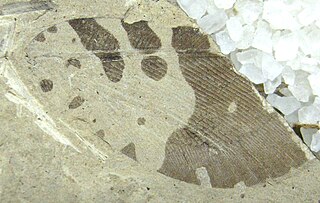
The order Afrosoricida contains the golden moles of Southern Africa, the otter shrews of equatorial Africa and the tenrecs of Madagascar. These three families of small mammals have traditionally been considered to be a part of the order Insectivora, and were later included in Lipotyphla after Insectivora was abandoned as a wastebasket taxon, before Lipotyphla was also found to be polyphyletic.

Sciurinae is a subfamily of squirrels, uniting the flying squirrels with certain related tree squirrels. Older sources place the flying squirrels in a separate subfamily (Pteromyinae) and unite all remaining sciurids into the subfamily Sciurinae, but this has been strongly refuted by genetic studies.

Marasmius is a genus of mushroom-forming fungi in the family Marasmiaceae. It contains about 500 species of agarics, of which a few, such as Marasmius oreades, are edible. However, most members of this genus are small, unimpressive brown mushrooms. Their humble appearance contributes to their not being readily distinguishable to non-specialists, and they are therefore seldom collected by mushroom hunters. Several of the species are known to grow in the characteristic fairy ring pattern.

The hairy Atlantic spiny rat, Trinomys setosus, is a spiny rat species from South America. It is endemic to Brazil.

Mugil is a genus of mullet in the family Mugilidae found worldwide in tropical and temperate coastal marine waters, but also entering estuaries and rivers.

The greater hedgehog tenrec, also known as the large Madagascar hedgehog or sokina, is a species of mammal in the family Tenrecidae. It is endemic to Madagascar. Its natural habitats are subtropical or tropical forests, shrubland and grassland, savanna, rural gardens, and urban areas.

Petinomys is a genus of flying squirrels. They are known commonly as the dwarf flying squirrels.

Temminck's flying squirrel is a species of rodent in the family Sciuridae. It is found in Indonesia, Malaysia, Myanmar, and Thailand.
Stenaelurillus setosus is a possible species of jumping spider from Myanmar and Thailand. It was described from a single immature male specimen. Stenaelurillus setosus was regarded as a nomen dubium by the World Spider Catalog as of January 2021.
Brasiliomyces is a genus of fungi in the family Erysiphaceae. The widely distributed genus contains seven species.

Turbo setosus, common name the rough turban, is a species of sea snail, marine gastropod mollusk in the family Turbinidae.
Starkovia is a genus of mites in the family Laelaptonyssidae. There are about eight described species in Starkovia, some of which were transferred from the genus Laelaptonyssus when it was determined to be a synonym of Starkovia.

Tenrecinae is a tenrec subfamily endemic to the island of Madagascar. It contains the largest species in the family, Tenrec ecaudatus. All members of the genus possess spines, analogous to those of hedgehogs, for defense against predators.

The Polyctenidae are a rarely collected family of parasitic bugs of the superfamily Cimicoidea. Polyctenidae species or bat bugs are obligate, hematophagous ectoparasites of bats. These insects are not to be confused with cimicid bat bugs, which are members of the family Cimicidae. A significant relationship appears to occur between the family groups and the species of hosts that indicates co-evolution and specialization.
Dolichancistrus is a genus of suckermouth armored catfishes native to South America.

Platynochaetus setosus is a species of hoverfly, from the family Syrphidae, in the order Diptera. It can be found from March to May in evergreen oak woodland in Spain, Portugal and other countries around the western mediterranean.

Haeterius is a genus of clown beetles in the family Histeridae. There are at least 20 described species in Haeterius.

Rhizomarasmius setosus is a tiny whitish mushroom having a distinctive hairy stem. It has been given the vernacular name "Beechleaf Parachute".

Palaeopsychops is an extinct genus of lacewing in the moth lacewings family Ithonidae. The genus is known from Early Eocene fossils found in Europe, and North America and is composed of ten species. The ten species can be informally separated into two species groups based on veination of the forewings, the "European" and "North American" groups. When first described, the genus was placed in the family Psychopsidae, but later was moved to Polystoechotidae, which itself is now considered a subgroup of the moth lacewings.

Macrophthalmus setosus is a species of sentinel crab found on the east coast of Australia, from around Queensland to Sydney. Macrophthalmus setosus is found low down on muddy river and creek banks and in exposed sea grass areas in tidal zones, at times near mangroves. Males have a tooth on the upper claw (dactyl). The carapace is around 40 mm wide, and rectangular, greater than 1.7 times wide than long. Eye stalks are long and thin.















